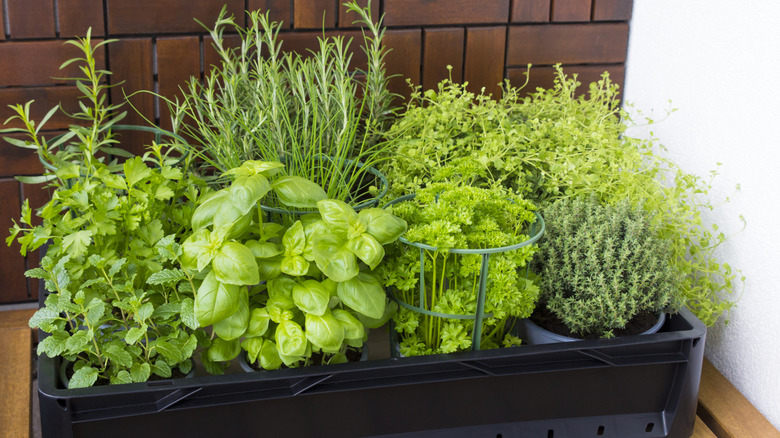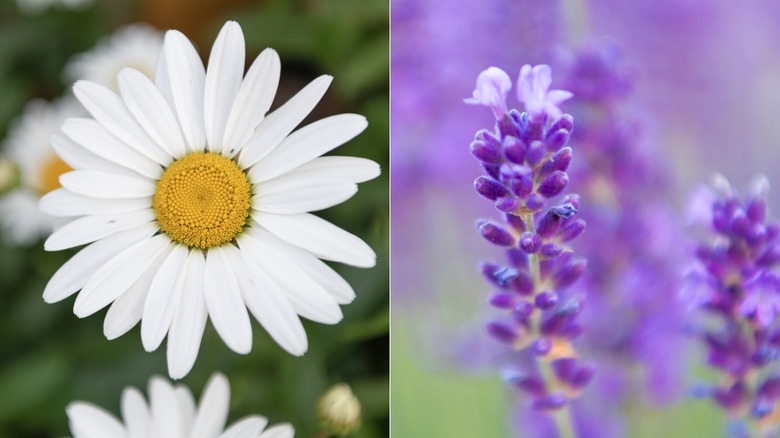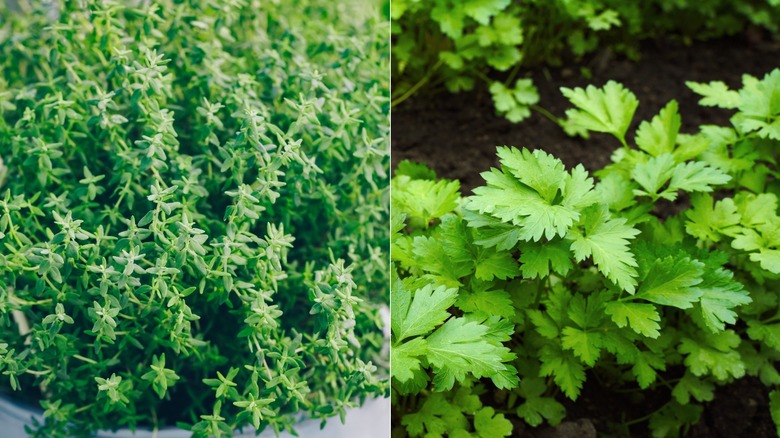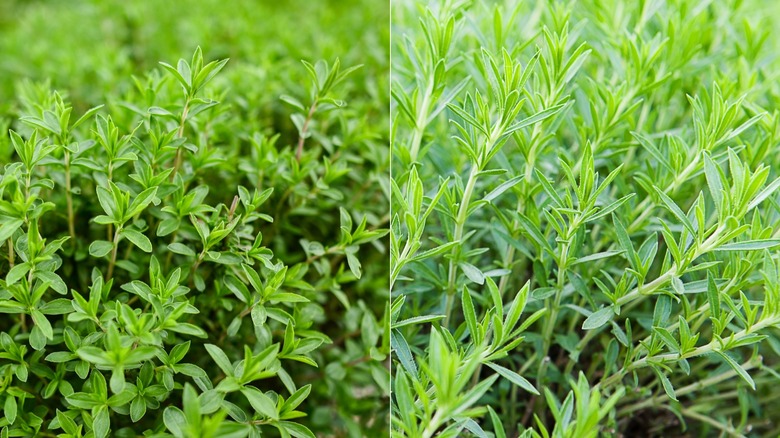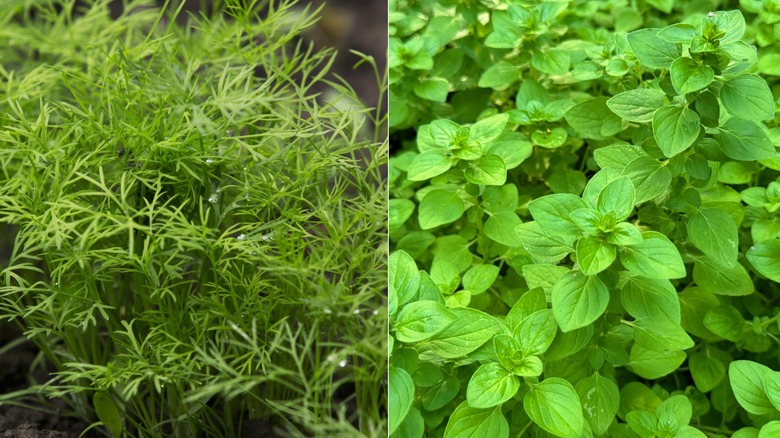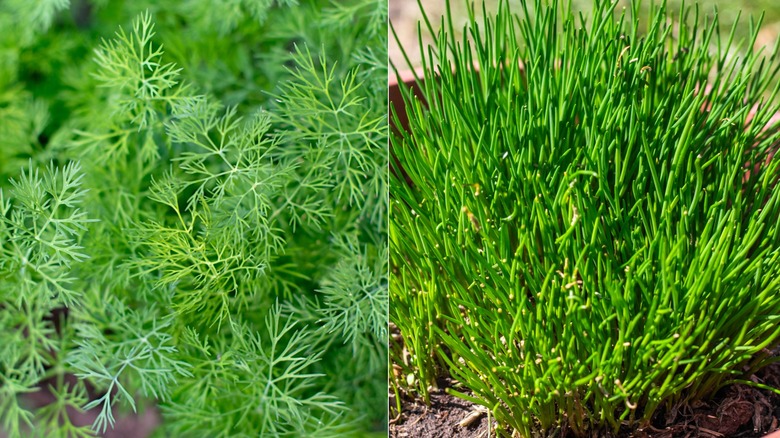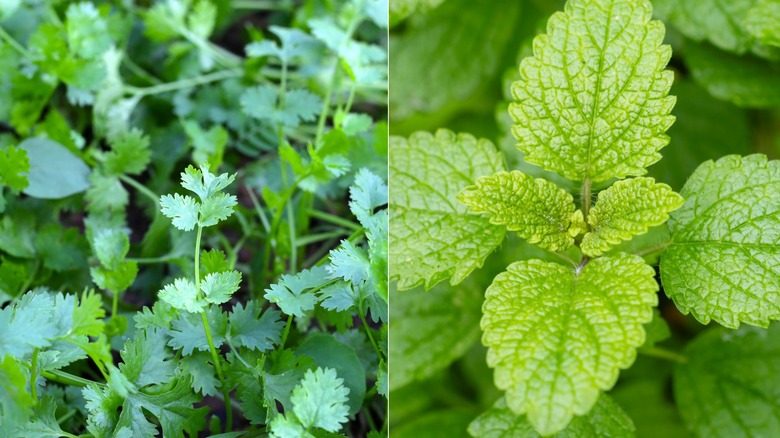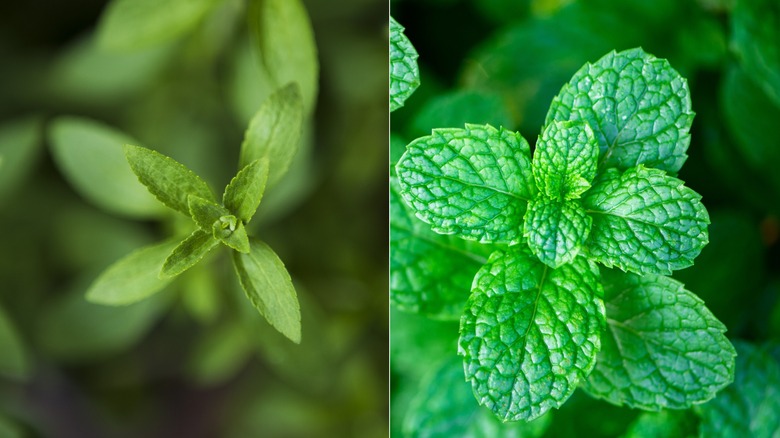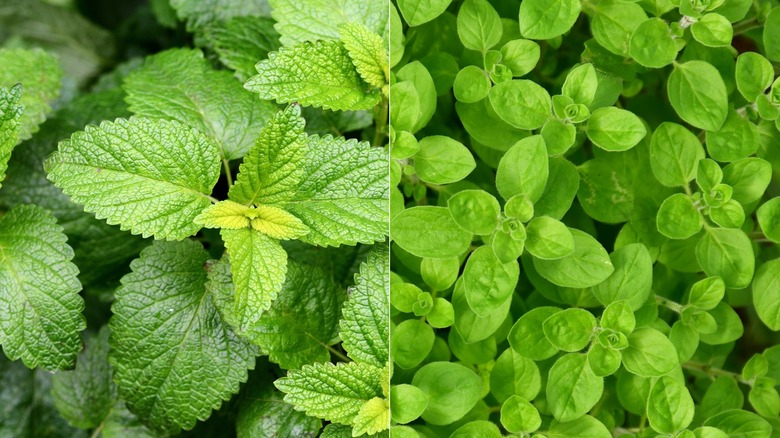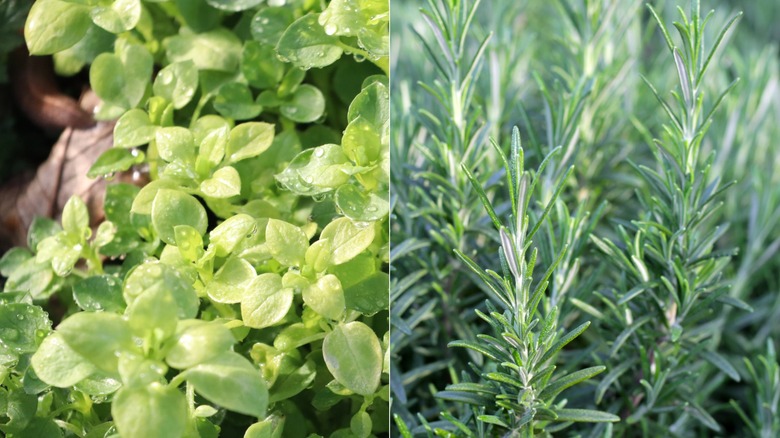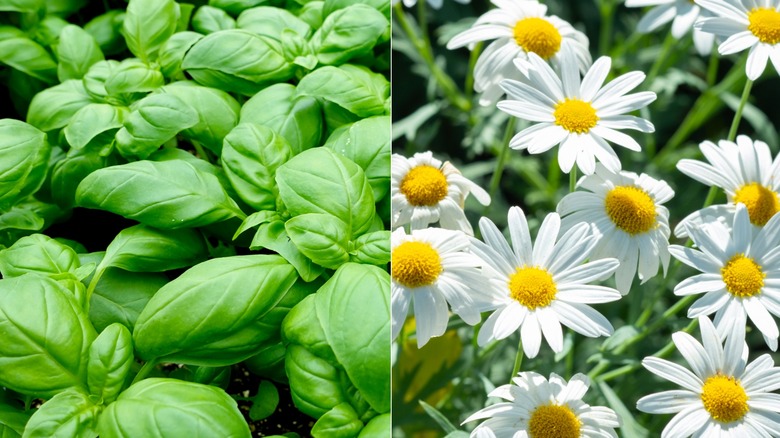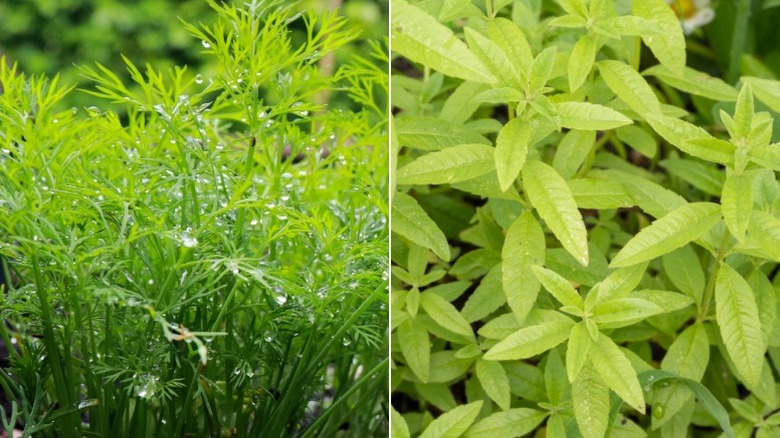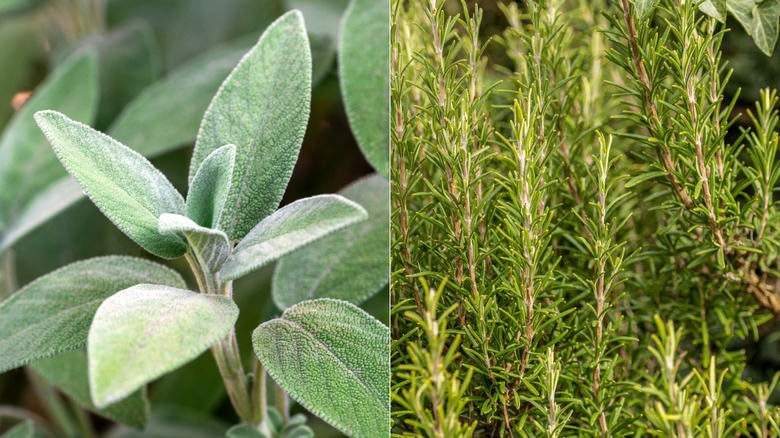20 Easy-Care Herbs That Grow Beautifully Together Indoors Throughout Winter
Many herbs don't handle cold weather well, like marjoram, basil, and chamomile. Thankfully, they are also generally easy to care for, and can be adapted to grow indoors over winter, as long as they are kept in a bright, sunny room. If you're limited on indoor space, it's a good idea to grow multiple plants in the same pot, but unfortunately, not every herb species will work well together. There are certain herbs that may not play well with others. For example, mint can spread quickly and may out-compete other herbs that aren't as aggressive.
Overall, though, most herbs are tolerant of being combined in one container, but it's important that they share similar requirements when it comes to moisture levels, watering, and sunlight, and they are in a pot that's big enough not to cramp the two plants. You may also want to consider their general size and aesthetic appeal together, since they'll be treated much like houseplants while kept indoors over winter. Generally, herbs that live in the same environment in the wild will grow together without much of a problem. Some examples are thyme and parsley, sage and tarragon, and thyme and rosemary.
Additionally, while this article only lists two herbs together for ease, if you have a big enough pot, you can set several herb varieties in one space. Generally, if one plant can grow alongside a few others, you can combine all of them together. For example, parsley grows well with both thyme and cilantro, so you could grow all three of these together since they have similar requirements.
Chamomile and lavender
Chamomile (family Asteraceae) and lavender (Lavandula spp.) go great together, both in a tea and in indoor containers through the winter. They enjoy bright, full sun and well-draining soil, which makes caring for them in one space easy. Additionally, chamomile can help keep away pests that may go for your lavender. It also releases chemicals to encourage growth, helping your lavender bloom sooner. These purple flowers tend to like a little air flow, so it's best to pick a shorter companion plant, such as Roman chamomile (Chamaemelum nobile), which generally stays under 6 inches tall.
Thyme and parsley
Thyme (Thymus spp.) and parsley (Petroselinum crispum) are also great plants to overwinter indoors in the same pots. There is a saying that the herbs you mix to add flavor to meals are often best grown together. While this isn't always true, it's a fairly good rule of thumb to follow with herbs. Italian plants, for example, can usually be grown alongside each other in containers, including these two. They will both enjoy being placed in a sunny spot during winter, with regular waterings and well-draining soil.
Oregano and basil
Basil (Ocimum basilicum) is a pretty picky plant that doesn't always do well with others. However, basil and oregano (Origanum vulgare) get along in confined spaces. In fact, it's thought that oregano can strengthen the essential oils in basil, improving its flavor. Additionally, oregano is fairly tolerant as long as it's grown alongside other herbs that like drier soil, including basil. Just be careful, as oregano can spread pretty quickly, being a member of the mint family. Be sure to harvest the oregano often enough to prevent it outcompeting your basil.
Sage and tarragon
Tarragon (Artemisia dracunculus) and sage (Salvia officinalis) are two herbs that are easy for even the most forgetful people to grow, and combining them in a container to keep over winter only makes the job easier. Tarragon and sage can get by with a little less sunlight than other herbs, so it makes sense to overwinter them together indoors. Both are Mediterranean herbs, so they'll taste delicious combined in a dish, and they'll look nice when planted together, creating contrast with their leaves.
Thyme and tarragon
Thyme and tarragon are from the Mediterranean and prefer dry and well-draining soils, which makes them excellent growing companions. Thyme also tends to cover the ground, while tarragon grows upward, allowing them to coexist easily in the same space. When working with a limited area indoors, this type of growth can be incredibly helpful. The only difference between these two herbs is that tarragon may prefer to have a little more nutrients in its soil, so if this herb seems to be struggling in the pot, it may be worth adding a little fertilizer.
Dill and oregano
Dill (Anethum graveolens) and oregano are excellent container plants to keep in a pot together. They both enjoy slightly drier soil, especially once established. Dill needs a little more water than oregano usually does, but if you grow oregano closer to the outside of a pot, dill can be planted in the middle and take advantage of the more moist parts in the center of a container. However, remember that the oregano can take over a pot, so watch it closely if you want them to continue to share a space.
Lemon verbena and cilantro
Lemon verbena (Aloysia citriodora) is an herb that grows well alongside cilantro (Coriandrum sativum), also known as coriander. Both offer bold and unique flavors, perfect if you're looking for fresh herbs to elevate your cooking. Spider mites, a common issue for indoor plants, can cause a lot of harm to lemon verbena, but cilantro does a good job of keeping them away while the plants spend their winter indoors.
Parsley and chives
Chives (Allium schoenoprasum) are one of the best companion plants for parsley in a pot indoors to overwinter. Their flavors work well together, and they share a fondness for moist and fertile soil. Additionally, chives slow down parsley from going to seed, which helps you to utilize the fresh leaves in your dishes longer. Even in cramped spaces, they don't have any negative effects on each other, either, which is a big bonus in indoor companion planting over winter. Plus, they look really neat when grown together in a space.
Dill and chives
Dill grows well amongst all alliums, including chives. Because of their strong smell, chives can also help keep away pests. They both can handle smaller areas, too, perfect for growing them indoors over winter in a home with limited space. Additionally, some people say that when you grow certain plants together, like chives and dill, it will help improve their flavors, leading to better dishes down the road. Both will tolerate cooler weather but need sufficient sunlight, so they may do best on a bright and cool windowsill during winter.
Cilantro and lemon balm
Cilantro and lemon balm (Melissa officinalis) are both uniquely scented plants. Thankfully, their odors complement each other, making them perfect to grow indoors in one pot. Sometimes, these two plants don't work outside together, because cilantro can attract pests that harm lemon balm, but indoors, these issues aren't as common. Both plants enjoy moist soil and at least six hours of sunlight. One thing to keep in mind is that lemon balm is part of the mint family, and can take over a pot, so it needs to be managed carefully.
Cilantro and parsley
Cilantro and parsley can be either great or bad companion plants, depending on their care and situation. Not only do they look very similar, but they also have almost overlapping growing requirements. While this can make parsley one of the companion plants that will totally thrive next to your flourishing cilantro, it also means they risk competing for resources. To give them the best chance and reduce the chances of one outcompeting the other, make sure you are giving them rich soil and fertilizer as necessary. They both also enjoy staying hydrated, so water them regularly.
Stevia and lemon balm
Stevia (Stevia rebaudiana) is another herb that works well beside lemon balm. Even if you haven't grown stevia before, you may be familiar with its name, as it's a popular natural sugar alternative. To care for these two herbs, you mostly just have to water them often, as both are fairly thirsty plants. They also enjoy lots of sunlight and soil that drains well but holds just a little bit of moisture, so overwinter them in a bright space. They are used in similar ways, which means it's handy to grow them together.
Lemon Balm and marjoram
Another plant that grows well in a container with lemon balm is marjoram (Origanum majorana). This is also a Mediterranean herb, and it has many similar requirements, including well-draining soil and a good amount of water. Unlike cilantro, marjoram actually helps keep pests away from lemon balm, potentially even the ones that affect houseplants. Technically, both are in the mint family as well, meaning they will try to fill up space, and end up checking each other so that neither party can fully take over the pot. You can also throw in another plant like stevia.
Thyme and rosemary
Rosemary (Salvia rosmarinus) and thyme (Thymus vulgaris) make a great pairing, and growing them in a pot together makes it easy to grab both for a meal. They are Mediterranean herbs that prefer well-drained soil and will need a bright, sunny space while indoors. Rosemary also grows a taller than thyme, which lets it get proper air flow. In pots, they may not give off the same pest-fighting benefits as they do in a garden, but their similar growing requirements make them a breeze to combine over winter.
Oregano and rosemary
Like thyme, oregano and rosemary share very similar needs, especially for water levels and full sun requirements. They also enjoy well-draining soil. Despite rosemary being tall, it doesn't grow large enough to fully shade out its companion or fight for space, and oregano won't overcrowd rosemary's stalks. Because of this, even if they don't provide a lot of specific benefits to each other indoors in a pot, their care is incredibly easy when they are grown together. Add thyme to this mix to round out a simple indoor herb garden.
Basil and chamomile
Chamomile is a fragrant flowering companion that will give your basil a boost. Some plants are said to improve each other just by being grown together. It's thought that chamomile can help basil produce more oil, which makes for a better flavor and may keep away pesky insects. They also have similar requirements for bright light and moist soil. Chamomile releases a soft fragrance that offers a subtle companion to basil's bold smell. Their vastly different appearances also create dimension and visual appeal, which can be a fun addition to your home through winter.
Marjoram and oregano
Marjoram and oregano are both in the mint family (Lamiaceae) and the Origanum genus, which is why they look incredibly similar. They also both enjoy warm and sunny locations, well-drained soil, and are drought-tolerant like many other Mediterranean plants. Despite their similar appearances, the two species have vastly different tastes, with oregano being rather bold and flavorful while marjoram leans on the sweeter and more subtle side. It's thought that growing them together enhances the flavors of both herbs, though you may want to have them clearly labeled to avoid a mix-up!
Dill and lemon verbena
Lemon verbena and dill can overwinter together in an indoor pot, as dill can do its part to keep away houseplant pests like spider mites. Additionally, it is one of the two herbs that help lemon verbena thrive when you move the pot back outside, attracting beneficial insects to your garden. When grown in a pot, lemon verbena should keep under 4 feet tall. Dill is generally much more accommodating, but can also reach around 3 to 4 feet tall, so give this pair a large container for the winter.
Sage and rosemary
Like most of the plants on this list, sage and rosemary have similar growing conditions, generally preferring full sun and excellent drainage. This makes them ideal herbs to overwinter in pots together on a sunny windowsill or in a conservatory room. It's thought that rosemary can also help to improve the growth and flavor of its companion, and their strong smell together helps them repel pests, while additionally producing beautiful flowers that are enjoyable to have in your home. They also look different enough to create a contrast that catches the eye.
Lemon verbena and thyme
Lemon verbena and thyme are both pretty adaptable plants, making them easy to grow with almost anything you plant alongside them, including each other. Lemon verbena and thyme prefer to be in full sun, and like to have a fair amount of water, but with well-draining soil. While they are both fragrant herbs that can make your whole home smell incredible, some may find the smell quite strong when grown together indoors. Lemon thyme (Thymus citriodorus) is another compatible option that may have a more congruent scent.
